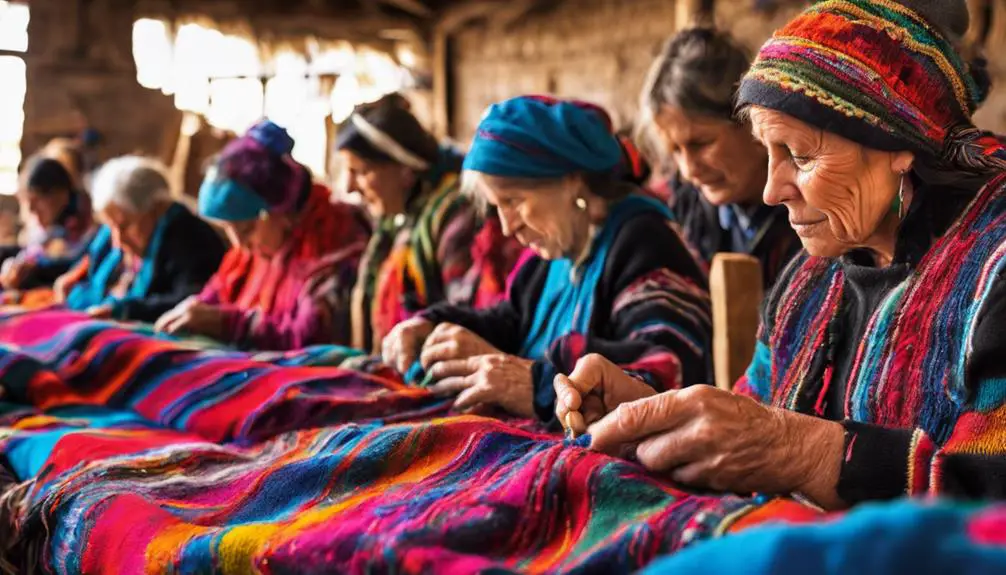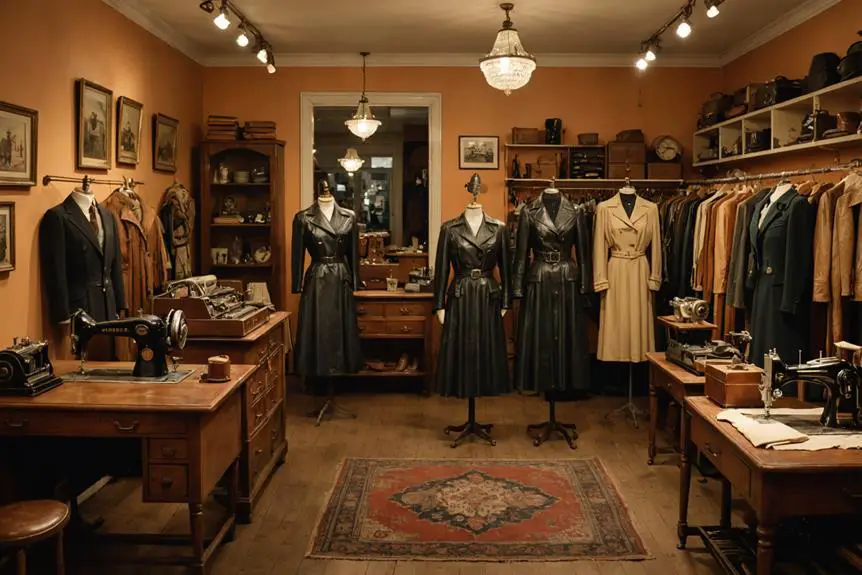When you're exploring the oldest Argentinian fashion brands, you can't miss Alpargatas, founded in 1883. Known for those comfy espadrilles, Alpargatas has a rich history and has been making an impact ever since. Then there's La Martina, which started in 1985 and has become a polo powerhouse. They're all about high-quality leather and stylish gear. Both brands reflect Argentina's vibrant culture and creativity, don't they? Plus, they've adapted to modern trends while staying true to their roots. Intrigued? Stick around; there's a lot more to discover about these iconic fashion forces!
La Martina History

La Martina's journey began in 1985 when Lando Simonetti established the brand in Argentina, focusing on crafting high-quality leather saddles and boots specifically for polo. Can you imagine the passion behind those first creations? As time went on, La Martina didn't just stop at saddles; it expanded into apparel and accessories, becoming a key player in Argentine fashion.
The brand really took off when it became the official supplier for Argentina's polo teams and even the Federation of International Polo. With team polo shirts designed for various countries, including the UK and USA, La Martina became a globally recognized fashion brand.
From sales of $1.2 million in 2000 to around $200 million by the 2000s, La Martina's growth is nothing short of impressive! Plus, in 2015, they opened their first store outside Argentina in London, marking a huge step in their international expansion.
And here's a fun fact: they actively fight against counterfeiting, working with law enforcement to keep their brand's integrity intact. Isn't that cool? La Martina's story is a true reflection of the spirit of Argentine fashion!
La Martina Partnerships
Building on its impressive reputation in the polo world, La Martina has forged numerous partnerships that elevate its brand and expand its influence. You'll be amazed at how this fashion powerhouse is not just a local favorite but also a global player! They're the official supplier for Argentina's polo teams and even the Federation of International Polo, outfitting national teams with custom-designed polo shirts. Pretty cool, right?
But it doesn't stop there! La Martina has teamed up with countries like the UK, USA, Brazil, and Dubai, showcasing its international reach. Plus, they've even partnered with prestigious universities like Harvard, Yale, Oxford, and Cambridge to provide branded apparel for their polo teams. Talk about a stylish education!
And if you think that's impressive, wait until you hear about their collaborations with luxury brands. They've created exclusive products that really enhance their reputation in the high-end fashion scene. They even designed technical clothing for team members of the Royal Salute! So, whether you're into polo or just love fashion, La Martina's partnerships are definitely worth talking about!
La Martina Events

Events play an essential role in La Martina's strategy to elevate its brand and connect with polo enthusiasts worldwide. You might be surprised to learn that La Martina isn't just a fashion brand; it's a key player in the polo scene. They co-sponsored the Maserati Centenary Polo Tour, bringing together 65 players from 12 countries! That's a big deal in the polo world.
But it doesn't stop there. La Martina also sponsored the Copa de La Martina polo championship, which really solidifies their presence in the polo event landscape. And get this: in 2014, they created a luxury saddle just for the Maserati event, mixing high fashion with equestrian sports. How cool is that?
La Martina takes every chance to showcase its products at global polo events, using them for exciting product launches and brand promotion. Plus, they're the official supplier for the Argentine polo teams and have even designed team shirts for countries like the UK, USA, Brazil, and Dubai. Talk about international reach! So, whether you're a polo player or a fashion lover, La Martina's events are definitely worth keeping an eye on!
Alpargatas Argentina History
Founded in 1883 by Juan Echegaray and Robert Fraser, Alpargatas Argentina began its journey focusing on the production of espadrilles. Who doesn't love a comfy pair of shoes made from natural fibers? By 1885, they officially became Sociedad Anónima Fábrica Argentina de Alpargatas, and just five years later, they expanded operations into Uruguay. Talk about ambition!
Fast forward to 1928, when Alpargatas opened a massive facility in Buenos Aires. This place turned into a major production hub for rubber-soled shoes in the 1930s. Can you imagine the hustle and bustle? Over the years, they launched popular brands like Pampero in 1972 and Topper in 1975, which really diversified their product range.
Alpargatas didn't just sit back; they adapted to various economic changes and challenges. They learned to navigate both local and international markets while building a strong brand presence. Isn't it inspiring to see how a company can thrive through ups and downs? Alpargatas Argentina is more than just shoes—it's a piece of fashion history that continues to walk alongside us!
Alpargatas Social Impact

Alpargatas has made a significant impact on Argentine society through its commitment to social responsibility. You might be surprised to learn that this iconic brand employs thousands of workers, mostly women, providing them with stable job opportunities in the textile industry. Isn't that amazing? By sourcing materials and labor locally, Alpargatas contributes to real community development, boosting the economies of the regions where it operates.
But there's more! Alpargatas also champions cultural ties by teaming up with local artists, giving a platform to Argentine craftsmanship and creativity. This not only keeps traditions alive but also enriches the brand's identity. Plus, their focus on sustainability is something to cheer about! They invest in eco-friendly production methods that protect the environment and empower artisans.
And guess what? Alpargatas has adapted its business model to embrace fair labor practices, aligning with international standards. This isn't just about making shoes; it's about making a difference! So, next time you slip on a pair of Alpargatas, you're not just wearing stylish footwear; you're supporting a brand that genuinely cares about social impact and community development. How cool is that?
Economic Challenges
The fashion industry in Argentina faces significant economic challenges that hinder its growth and sustainability. You might wonder why so many local artisans struggle, right? Well, Argentina's complex economic policies make it tough for them to reach international markets. This really affects traditional textile production, which is rich in history and culture.
Currency volatility adds to the headache, complicating things for established brands. It can take ages to register as exporters, and customs delays? Don't get me started! With many artisans battling poverty and competition from industries like mining, opportunities for growth seem slim. And guess what? The sheep wool industry has taken a serious hit too, with sheep populations plummeting from 21 million in the 1950s to just 8.5 million by 1999. That's a huge blow for wool-based fashion brands.
To make matters worse, synthetic fibers have barged into the scene, leaving natural fiber markets in a lurch. Many textile factories are abandoned, and production capacities are dwindling. So, despite all the talent and potential, these economic challenges continue to hold back Argentina's fashion world. Isn't it time we change that?
Sustainable Textile Practices

Amidst the economic challenges faced by Argentina's fashion industry, there's a growing movement towards sustainable textile practices that offers a glimmer of hope. You might be wondering, what exactly does this mean? Well, it's all about using materials that are better for the planet. One standout option is guanaco wool. Sourced from wild guanacos, this fiber is not only incredibly soft, but it also has a lower environmental impact compared to traditional sheep wool. Talk about a win-win!
Now, it's crucial to emphasize that guanacos are a protected species, so conservation efforts are essential. These efforts can complicate how we commercialize their wool, but they help guarantee that these amazing animals don't become endangered.
In Argentina, initiatives like Hecho por Nosotros are stepping up. They're supporting local artisans and promoting sustainable practices that include using guanaco wool. Imagine if more artisans could tap into this market! Revitalizing Argentina's textile industry through sustainable practices could protect biodiversity and boost local economies. So, why not get excited about the potential of guanaco wool? It's a step towards a brighter, greener future for fashion in Argentina!
Future of Fashion in Argentina
Argentina's fashion scene is on the brink of transformation, as emerging designers are capturing global attention with their innovative collections. This is super exciting, right? With a rich cultural heritage and unique materials like guanaco wool, the country is all set to embrace sustainable fashion practices that eco-conscious consumers are craving.
You'll see established brands stepping up, focusing on quality and fresh designs, while new labels tell their stories through natural fibers. It's like they're weaving a narrative that connects their roots to the global stage. Plus, there's a growing interest in Latin American fashion, which is making waves internationally.
And let's not forget about partnerships! Collaborations between local artisans and designers are key for getting broader market access. Isn't it amazing how teamwork can boost creativity?
With international support and development organizations cheering them on, Argentine fashion brands are becoming more competitive globally. So, get ready! The future looks bright, and you might just find your next favorite outfit from an up-and-coming Argentine designer. What's not to love about fashion that's both stylish and sustainable?
Frequently Asked Questions
What Is the Most Popular Clothing in Argentina?
In Argentina, you'll find that Argentinian streetwear blends comfort and style, reflecting regional fashion influences. Denim jeans and relaxed knitwear dominate urban outfits, while gaucho attire remains a proud symbol of the country's heritage.
What Brands Are Argentinian?
When you explore Argentinian designers, you plunge into a rich fashion history. Brands like Rapsodia and La Martina showcase vibrant styles and cultural influences, making them prominent players in both local and global fashion scenes.
Why Is La Martina so Expensive?
La Martina's prices reflect its commitment to luxury materials and exceptional craftsmanship details. By sourcing locally and collaborating with prestigious brands, they guarantee exclusivity and quality, justifying the premium you pay for their products.
What Is Traditional Argentinian Clothing?
Traditional Argentinian clothing reflects a rich heritage, incorporating gaucho attire like bombachas and ponchos. You'll notice vibrant colors and intricate designs from indigenous textiles, showcasing the country's unique blend of cultures and craftsmanship.




